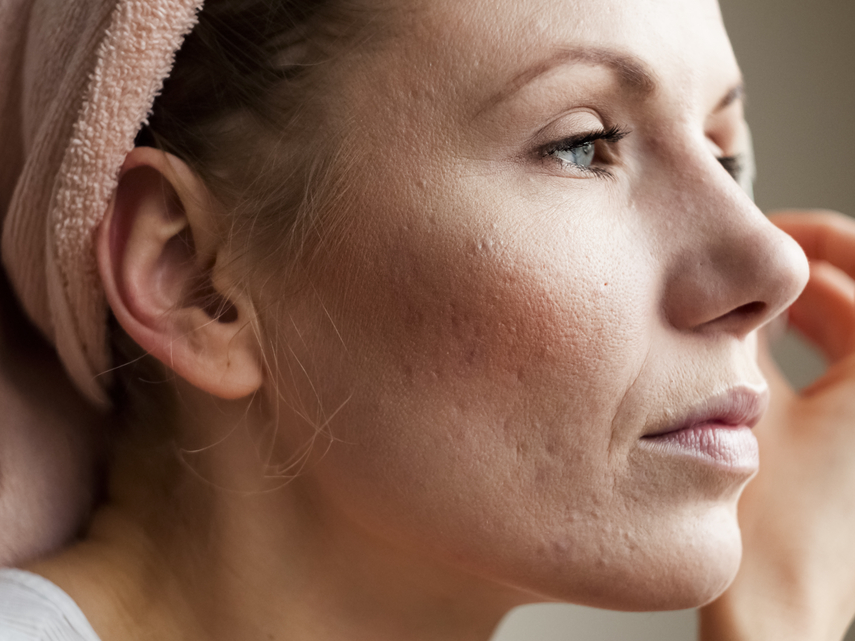- Dermatologist Dr. David Lortscher said there are multiple types of acne scars including rolling, boxcar, and ice pick scars.
- When it comes to treating acne scars, he suggests dermabrasion, fillers, lasers, and steroid injections.
- Acne marks are different from acne scars and are considered hyperpigmentation.
- To treat acne marks, Lorscher recommends products with niacinamide, azelaic acid, and alpha hydroxy acids.
The only thing that can be worse than acne is the scarring it can leave behind. These ghosts of acne’s past are a phenomena of their own and should be treated as such, according to board-certified dermatologist and CEO of Curology, Dr. David Lortscher.
To help you battle your post-breakout acne scars, INSIDER spoke to Dr. Lortscher about everything you need to know about them, including how to help treat them.
The first step in treating acne scars is to recognize what type you have

According to Dr. Lortscher, many variables come into play with the formation of acne scars. It all depends on the type of acne scar you have, and while there are a variety of acne scars, they can fall into two verticals: depressed (atrophic), or raised (hypertrophic).
"Depressed scars result from the destruction of skin cells caused by inflammation in deeper layers of skin," he said. "In other words, if an acne pimple is so inflamed that your skin's collagen is destroyed, and not enough collagen is produced to rebuild the skin, you end up with a depressed scar. On the other hand, if the healing response gets a little too enthusiastic, it may result in a raised scar."
Dr. Lortscher noted that raised hypertrophic scars can extend beyond the margin of the original acne wound (aka a keloidal scar), and they are less common than atrophic scarring.
Other types of acne scars you should look out for are:
- Rolling: These scars tend to be wide, shallow depressions on the skin. They have a "hill and valley" texture to them and are only slightly indented.
- Boxcar: These U-shaped, crater-like wide depressions can be shallow or deep. They tend to also have sharp edges.
- Ice pick: These scars are narrow depressions, but tend to go deeper into the skin than other acne scars. They have steep edges and taper to a narrower base.
If you're suffering from pigmented spots, then this is considered hyperpigmentation - aka, acne marks. While these two tend to get lumped together, Dr. Lortscher notes that they are entirely different.
"Scars change skin texture, not just color, and are considered permanent," he said. "Meanwhile, marks and dark spots from acne tend to fade in six to 12 months, or less."
There are various treatments available for treating acne scars

When it comes to acne scars, Dr.Lortscher said that unfortunately there is no way to make them entirely disappear. He said that each person's skin is entirely different, and can have different results to treatment options - even medical treatments. With that being said, there are ways to help improve their appearance.
To help improve the look of your acne scars, Dr. Lortscher advises visiting your favored dermatologist or licensed esthetician for these treatment options:
Punch excisions
During this procedure, a professional cuts out the scars and closes them with stitches. According to Dr. Lortscher, this procedure is helpful for very small ice pick type scars.
Fillers
Injections of fillers, such as Restylane or Juvederm, may be used to improve certain types of depressed scars with softer edges.
Lasers
Lasers are one of the most popular procedures for acne scarring. According to Dr. Lortscher, laser treatments can be customized to different wavelengths, energy, and density for different types of acne scars. While results may range from a mild to marked reduction in scarring, he notes that this option is not typically covered by insurance and may be costly. A careful exploration of the options and their associated risks, as well as an understanding of reasonable expectations is necessary, according to Dr. Lortscher.
Dermabrasion
Dermabrasion is another popular procedure in the skincare world. It's a technique similar to deep sanding or scraping: "It removes the superficial skin layers to allow new skin cells to migrate across the wound from underlying skin structures such as the lining of pores and from surrounding untreated skin," Dr. Lortscher said. "Dermabrasion may be used primarily for improving contour and color match between the scar and that of the normal skin."
It's a viable option for moderate to severe scars, but should only be done in experienced hands.
Microneedling
Microneedling is a skin-care procedure that involves puncturing the skin with multiple acupuncture-sized needles. It creates a small "injury" to the skin, which increases collagen and elastin production, thus improving scars and reducing hyperpigmentation. According to Dr. Lortscher, deeper penetrations result in pinpoint bleeding and can offer more improvement.
Fractional radiofrequency (microneedling with heat)
This procedure involves heating the skin in the area of the acne scar, which results in new collagen formation. This helps to improve the appearance of the scar and skin texture.
Steroid injections
Thick, lumpy scars, termed keloids or hypertrophic scars may benefit from corticosteroid injections in a local dermatologist's office.
Peels
Peels are a trending option for a variety of skincare needs, but Dr, Lortscher notes that a peel would need to be very deep to offer improvement. He recommends reviewing this with your dermatologist, as there are many variations of peels that can be done.
Tretinoin
Tretinoin, a prescription vitamin A derivative, can help scarring somewhat in the long-term, due to its collagen-stimulating effect and can be found in some Curology and other over the counter formulas. "We don't see miracles with tretinoin, but it can help texture change a bit, over the course of months," Dr. Lortscher said.
Acne marks are different than acne scars and require different treatment

Unlike acne scars, Dr. Lortscher said that acne marks are usually not permanent, and fade within six months to a year. But if you want to speed the healing process up, here are a few tips and products that he finds helpful:
Azelaic acid
According to Dr. Lortscher, azelaic acid can help reduce marks left by acne. "Azelaic acid works by lightening any dark spots left by acne scarring or sun exposure by slowing the production of melanin, and by blocking abnormal melanocytes - pigment-producing cells that have gone haywire," he said. Azelaic acid is only available through prescription, but you can easily get it through one of Curology's custom prescription-grade formulas if it's deemed necessary for your skin type.
Niacinamide
"Niacinamide is a potent agent in minimizing dark spots and hyperpigmentation," said Dr. Lortscher. "Niacinamide works by blocking the pigment from surfacing on the outer layer of skin. With the continuous application of niacinamide, dark spots will begin to fade from the reduction of pigment supply. You can get prescription-strength niacinamide in your Curology custom formulas or use lower concentrations over the counter." One over the counter option Dr. Lortscher recommends is the fan-favorite Paula's Choice 10% Niacinamide Booster.
Tretinoin
"Tretinoin is a potent prescription retinoid derived from vitamin A, which can improve the hyperpigmentation left behind by acne blemishes," said Dr. Lortscher. This product can be found in various prescriptions, Curology, and over the counter products
Alpha hydroxy acids (AHA)
While physical exfoliators and scrubs are popular, Dr. Lortscher recommends swapping for a chemical exfoliator. "Other topical exfoliating treatments such as alpha hydroxy acids (AHA) may be beneficial for acne marks," he said. He notes that St. Ives Exfoliating Pads contain lactic acid, a popular AHA.
Visit INSIDER's homepage for more.

